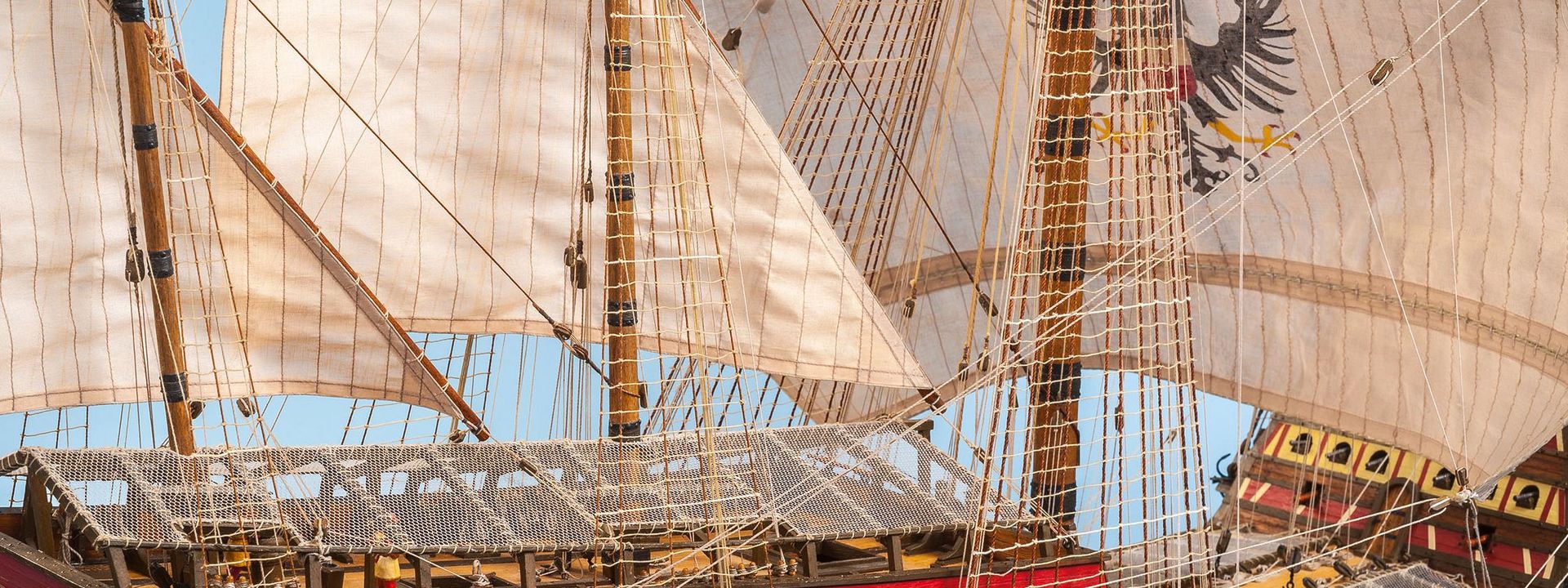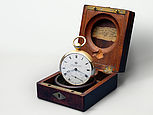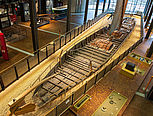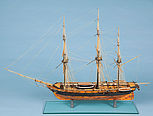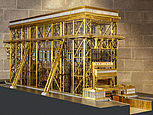The Cultural History of Shipping
Visitors to the Shipping exhibition are welcomed by Captain Nemo on an imaginary set of his submarine, the Nautilus. The mariner from Jules Verne’s novel 20,000 Leagues under the Sea talks about the nature of water, the oceans, and dangers at sea. And he tells myths – about sea monsters and figureheads, the decorative sculptures at the prows of ships. Many sailors believed the soul of the ship resided in the figurehead. Any damage it sustained was considered a bad omen.
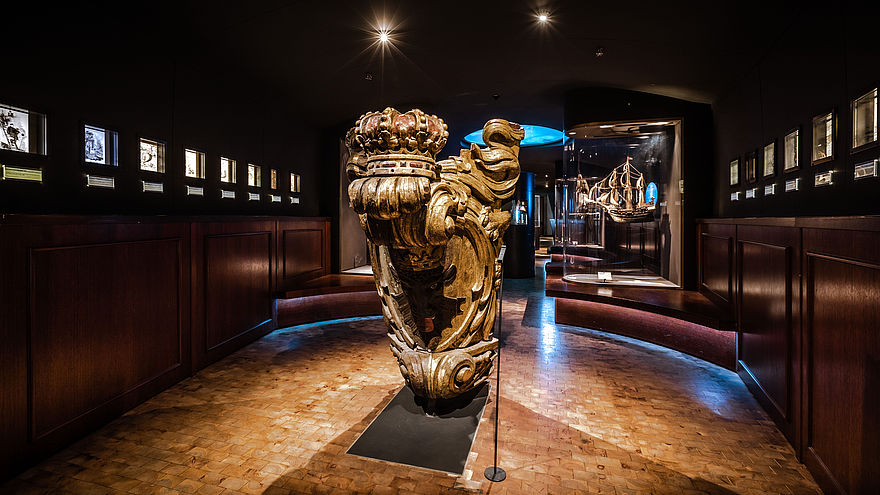
SDTB / H. Hattendorf
What it was like to live on board a ship is reflected in countless stories, myths, symbols, and aphorisms dealing with the interaction between people, boats, and the sea. More than 1,100 objects, dived into 30 thematic exhibits and spread across 6,500 square meters of exhibition space on three levels, provide insight into the history of deep-sea and inland navigation. This is one of the world’s largest exhibitions devoted to ships and boats.
From the Leather Boat to the Aircraft Carrier
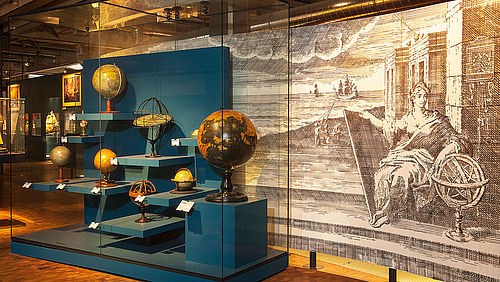
SDTB / C. Kirchner
The heart of the exhibition is devoted to deep-sea navigation. It starts with the chronologically structured exhibit “Ships and History.” Fifty-two model ships (scale 1:50) show developments in size and shape over the last 10,000 years – from the leather boat to the aircraft carrier. Other exhibits focus on a wide variety of themes relating to deep-sea ships. Five alone are devoted to the history of seafaring and different types of navigation: from rudimentary navigation devices to modern GPS.
Without advances in navigation devices, the voyages of discovery undertaken by Portugal and Spain around the year 1500 would not have been possible. These voyages in turn changed navigation techniques and ship design, gave way to a new conception of the world, and established a new balance of power on the high seas. The exhibition is rounded out with sections on sea rescue, whaling, and the production of sails and rigging.
We are currently working on a new presentation of the Berlin-Brandenburg slave trade. By the way of an artistic performance, we deconstructed a former exhibit on the topic in collaboration with civil society organizations. The performance can be watched in the exhibition.
How Does a Ship Behave in Water?
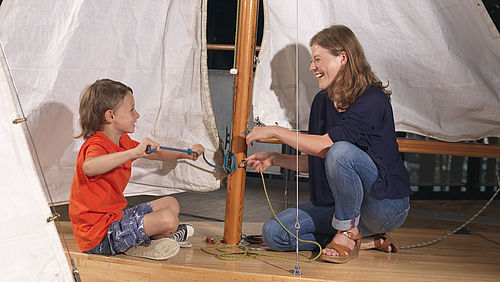
SDTB / F. Grosse
For thousands of years, shipbuilding and its many challenges remained the province of purely experiential knowledge. Only in the 18th century did mathematics start playing a role in ship design. Visitors to the exhibition will discover what forces act upon the hull and how ships move through the water. They can even try their hand at setting a sail and tying nautical knots.
Inland Navigation between the Elbe and Oder
The ground floor begins with an exhibit on “Water Sports in and around Berlin” featuring many original sailboats, rowboats, and motorboats. After that comes “Inland Navigation between the Elbe and Oder.” Shipping on the many waterways around Berlin provided an indispensable foundation for the city’s development, with so-called Kaffe barges transporting large quantities of building materials from outlying areas. Locks and boat lifts made it possible for boats to overcome differences in elevation both small and large, and thus to smoothly continue their journey on the network of rivers and canals. Historic models are also on display that once belonged to the Institute and Museum of Oceanography and the Transport and Civil Engineering Museum (both now defunct).
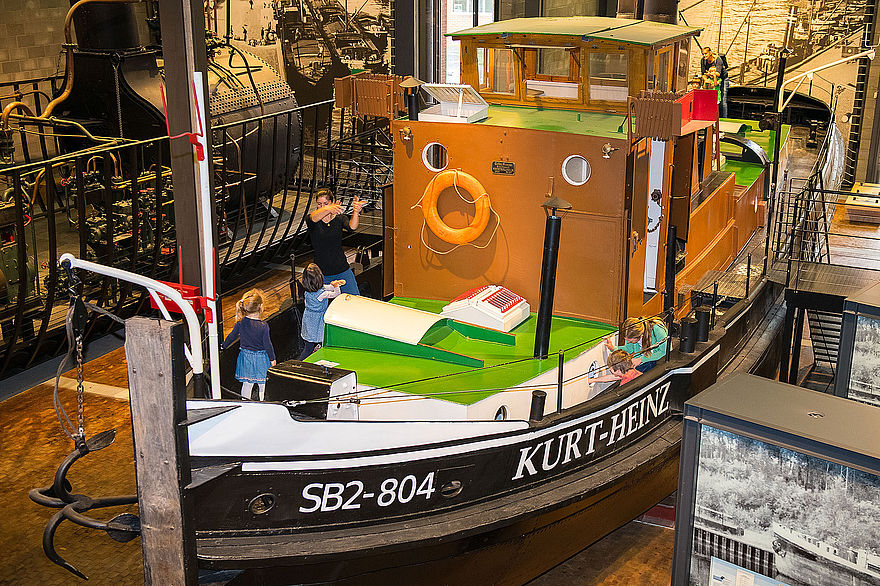
SDTB / C. Kirchner
On his voyages, Thomas Cook discovered many new plants and animals, which were documented in drawings. The British ENDEAVOUR, built in 1764, was refitted as a research vessel for his voyages.
SDTB / V. Kreidler
Museum visitors can test their knowledge at hands-on exhibits. Navigating the Elbe estuary requires careful steering.
SDTB / C. Kirchner
Fifty-two model ships made over the last 500 years are arranged chronologically. They illustrate the discovery of foreign continents and the influence of shipping on culture and trade.
SDTB / H. Hattendorf
The splendid wood carving on the Swedish VASA, from 1628, shows that ships were also intended to be monumental objects and expressions of power.
SDTB / C. Kirchner
The large red propeller of the JEAN COUSIN juts out from the engine room, which contains the steam engine, auxiliary units, and the boiler.
SDTB / Müller
This one-man Biber submarine from 1944 was developed to attack ships lying at anchor. Due to its technical defects and the inadequate training of its young pilots, sixty to seventy percent of them died.
SDTB / C. Kirchner
Highlights

Pocket chronometer used by Alexander von Humboldt
The king of Denmark gave Alexander von Humboldt this precision timepiece in 1830. For a while it was kept in the Berlin observatory, as Humboldt noted on the top of its mahogany box. Alexander von Humboldt made a journey to the Americas in 1799, thus ushering in a new era of research voyages using state-of-the-art scientific instruments.
Johann Heinrich Kessels, 1828

Kaffe barge
As the saying goes, “Barges built Berlin.” Berlin owes its development to the many surrounding waterways, on which large quantities of building materials were shipped to the city. This Kaffe barge, salvaged from the Havel River, dates to about 1840. It was loaded with roof tiles when it sank. It is the largest object in the exhibition.
ca. 1840

Model of the Glattdeckskorvette CREOLE (1826)
A (sailing) corvette was a three-masted, full-rigged warship smaller than a frigate. The Glattdeckskorvette CREOLE had only small structures at the bow and stern instead of a forecastle and poop deck. These fast ships were mostly used for reconnaissance. The model of the CREOLE is built to a scale of 1:50.
Michael Keyser, 2003

Model of the Niederfinow Boat Lift
Locks, inclined planes, and boat lifts make it possible for boats to overcome differences in elevation between sections of a canal. At the boat lift in Niederfinow, a 36-meter elevation difference is overcome in five minutes. This brass model (scale 1:50) will show you how it functions. It took 20 years of work at the museum, most of it done by volunteers, to finish the model of the Niederfinow Boat Lift.
Rudolph, Lambrecht, Masella, Tannenberg, 2014

